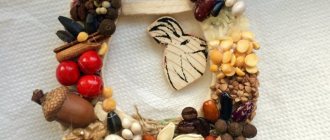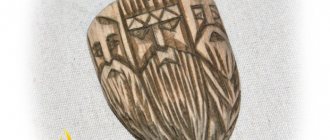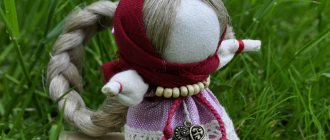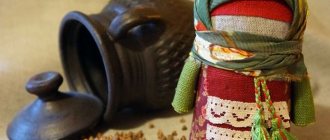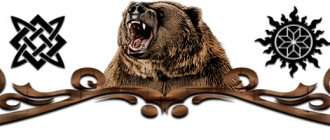Trees are important for human life and health. Since ancient times, it has given a person a home, warmth (fire), food, protection. The ancestors personified trees with spirits and believed that they had a magical principle. That is, due to the influence emanating from the plant they receive a charge of energy. Wooden amulets are widely used. The Slavs valued them. Later, the demand for products fell, but now it is increasing again.
Slavic amulets made of wood and their meaning
Wooden amulets provided protection from diseases, evil forces, material shortages and damage. Much depended on the quality of the chosen base. The most strength is found in aspen, oak and birch. They protected people from witches, sorcerers and other evil spirits.
Now people have abandoned the use of wood in everyday life. Expensive metals, silver and gold began to be used as jewelry. For the Slavs, a home talisman was valuable; it showed respect for the divine beings in whom they believed. Nature was considered the only carrier of pure energy.
Hazel amulets ↑
A hazel amulet is perfect for a person of a creative profession. Such people are periodically depressed due to a lack of new ideas. So, a hazel amulet can become a muse for such a person.
Put hazelnut in jewelry
By choosing this tree to make a talisman for yourself, a person can also protect his home. In ancient times, hazel was used to make a cane or staff, which was left at the entrance to the house. It was believed that such an object would protect the house from evil people and slander.
The easiest way to make a talisman from this tree with your own hands is to place the nut in the place where you store jewelry. It was believed that the nut imparts its protective properties to the jewelry, and they, in turn, protect the owner.
The power of a wooden amulet
Wooden Slavic amulets are used by everyone without exception, but they are especially suitable for people who are capable of solitude with nature and who know how to listen to it. Amulets are worn not only by adults, but also by children, regardless of faith.
The Slavic amulet is made from natural materials, but it performs different functions depending on what was used to create it:
- A birch log house protects a person from slander, curses and the evil eye.
- Oak energizes and prolongs life. Previously, he was placed in the crib of newborns so that they would get stronger. Such talismans were given to young boys to gain courage and protection on the battlefield.
- Alder was used to strengthen strength and intelligence. Wives gave such amulets to their husbands so that other women could not seduce them.
- Rowan was used to protect the house from evil spirits.
Wooden amulets: how to choose and buy
A Slavic amulet made of wood is bought at fairs or in an online store, but before purchasing, the purpose of use is determined. There are not only breast symbols, but also signs that decorate and protect the home.
The Slavs believed that wooden carvings should be placed on all places in the hut that were vulnerable to dark forces. To ensure the work, the sun was applied to the object in several positions, the sign of Perun, a horseshoe and figures of gods and goddesses.
You shouldn’t make a hasty choice or make a purchase thoughtlessly. It is better to choose the appropriate type of wood, the protective properties depend on it. Birch, oak, alder, aspen amulets and magical products made from willow are popular.
The meaning of talismans made by yourself
Self-made Slavic amulets made of wood had a sacred meaning, because nature was the best friend for the Slavs. She supported them, gave them strength and protection. There was a belief that the tree contained the souls of ancestors, and they acted as a kind of guardian for the person wearing a protective talisman. The products were considered strong talismans, and protection was defined as limitless.
Not every amulet can work correctly. All amulets are individual, so their beauty is considered the last thing. Choosing a suitable talisman is not always possible; moreover, a handmade product is more valuable.
Before applying the ornament to the product, clarify:
- who it is intended for - a man or a woman;
- clarify the person’s date of birth and specify the patron;
- determine the purpose of using the amulet.
To begin with, a suitable material is determined taking into account its properties.
How to store the amulet and how to care for it?
In order for the talisman to serve for a long time and the symbol not to be erased, you can apply wax to the surface. After the wax has hardened, peel it off and apply another layer of wax on top. Repeat until the wax fills the hole in the cut out symbol.
You can clean the amulet with water. Just don’t keep it in water for too long; just rinse it under clean spring or holy water. It is not necessary to wear the talisman on your body; it can be placed in your pocket or a secluded place.
If you make a talisman out of wood, and after a while you notice a crack on it, then you can say with confidence that the magical protector has taken a negative blow. Often, due to damage or the evil eye, not only amulets burst, crack, but also other objects that, for one reason or another, take on all the negativity. In this case, the used amulet should be burned, and then a new one should be made.
Slavic amulets made of wood can also equalize blood pressure, improve blood circulation and relieve pain. To do this, you need to determine which tree is suitable for a person. This is done using the Druid calendar. You can carry the amulet with you, or you can use it only in case of illness.
The magical powers of different types of trees
The wooden amulet is designated as the most significant in the life of the Slavs. This material, unlike metals, has been available to man since ancient times. Bronze, copper, gold, silver and other precious and semi-precious items could only be used by rich people. They created the talisman from wood themselves due to the availability of the material.
Different breeds are used for making, but each of them has its own meaning, provides protection and helps in some way. The Slavs personified a tree and assigned it a special biofield, so objects were created taking into account compatibility.
Birch
This breed has soft and gentle energy, which is why women and girls of different ages wore birch amulets. Products were created not only from logs, but also from branches.
What birch can do:
- drives away negativity from a person’s aura;
- eliminates evil intent;
- fulfills cherished desires.
The tree was considered generous. The Slavs used all parts: they made decoctions from the buds, leaves and bark, and drank juice. They made baby cradles from logs.
Aspen
The properties of this tree differ from those of birch. It does not give energy to a person, but absorbs a negative charge. Wearing an aspen amulet helps to avoid the evil eye and damage. The material was used to expel evil spirits, black sorcerers and witches.
Aspen amulets were not just worn on the body. They were laid under the corners of the foundation and placed in the barn. During misfortunes, wars, diseases and other pestilence, aspen stakes were driven on four sides of the settlements.
You cannot carry an accessory made of this material with you for a long time. It is customary to remove it as soon as the illness or damage goes away. Taking it off and putting it in a box is not enough; you need to hand the thing over to the earth so that the disease goes away forever.
Hazel
It is a symbol of wealth and abundance. Amulets can attract wealth. In the barns, tree branches were placed near the cattle so that they would produce more products.
In addition to providing prosperity, hazel performs other functions:
- protects a person from diseases;
- helps to find love;
- opens a person’s creative abilities;
- protects housing from looting and other troubles.
Rowan
There are many beliefs associated with this tree. Rowan is warlike, it helps to resist evil. Berries have long been valued; they were considered the fruits of love. The presence of branches of this tree in the house helped to inflame fading feelings and make life joyful. That is why bunches of berries were hung in the corners of the monastery or simply kept in a visible place.
Other qualities of the material are also highlighted:
- is able to give a woman beauty and prolong youth;
- protects the wearer from evil glances;
- absorbs negative energy directed into the house;
- able to protect the family.
To ensure protection of the clan, rowan trees were planted at the grave of an older deceased relative, then log houses were made to create permanent amulets for the home.
What is special about wooden amulets compared to other amulets?
People have always tried to protect themselves from witchcraft and other negative influences. For protection, various raw materials were used: stone, animal fangs, etc. Some materials were difficult to work with; you must agree that only a specially trained person can apply a protective symbol to a stone. Other difficult to obtain, getting the fang of a wolf or other strong animal is not something everyone can do. Unlike others, wood is an accessible raw material, it grows in almost any area, it is a fairly soft material to work with, and besides, amulets made from it are suitable for almost everyone.
For men, amulets made of hazel, oak, and ash are suitable; they will help the owner gain powerful protection from black magic, gain courage, bravery and good luck in business. It is better for women to wear talismans made of cherry, alder and rowan. They will bring harmony to the family and protect them from negative energy influences. Birch talismans were used to protect children from the evil eye. When working with these amulets, you should adhere to the rules of caution, because some tree species have the qualities of vampires - these are poplar and aspen. Charms made from them should not be worn constantly.
The meaning of the amulet shape
Not only the wood and the ornament applied to the material mattered, but also the shape of the amulet:
- A amulet in the shape of a circle is worn by people who want tranquility and peace, who live a measured life. This is the personification of the luminary, bringing harmony and prosperity to life.
- The square amulet is a symbol of the unification of all four elements. It suits confident and strong people. Helps you make the right decisions in the most difficult situations.
- The triangular shape is the most difficult. People with superpowers and engaged in sorcery preferred to wear such a wooden accessory. It was believed that a wooden triangle with a special ornament on the neck helps to communicate with higher powers.
- The oval came into use much later than the three previous shapes. Such a product can make a person lucky.
A talisman is a symbolic thing, so it must be protected. It should not be passed on to anyone without good intentions.
Manufacturing rules
Basic recommendations for creating magical jewelry are as follows:
- First, a material is chosen that is energetically similar to the future owner.
- Before applying a sacred sign or rune to a log house, you need to study its meaning. Carving must be done carefully to avoid mistakes.
- All creation work must take place in silence. The manufacturer must be in a good mood, he should not have evil thoughts, because the tree is able to absorb energy like a sponge.
- You can create a talisman for a man on Monday, Tuesday or Thursday, for a lady - on women’s days.
- The amulet will receive an additional charge of positive energy if the product is made by a blood relative. Making a protective device for yourself is not recommended.
If a wooden product is purchased ready-made, it must be cleaned before wearing. It is enough to hold it over the flame and read the plot.
Runes on wooden amulets
These are ancient signs that help to lift the curtain of the future and look into it. Runes are often applied to all kinds of talismans. It is impossible to study this topic superficially; deepening is necessary. To obtain basic knowledge, you need to familiarize yourself with the minimum set containing 24 runic symbols. It must be borne in mind that not each of them is compatible with the type of wood.
Amulet of Veles
To create such amulets, spruce or cedar logs are often used. Veles amulets made of wood are used to protect children. The Slavic god protects them, so during times of misfortune, children always hid in the forest under spruce branches. The product must be double-sided. Special signs are applied not only outside, but also inside. It is impossible to drive the talisman into metal frames when making a frame, otherwise the amulet will not work.
Guardian Spirit Chura
This is a special creature, the talismans in the form of which have unique energy. The spirit is ranked among the ancient divine family, endowed with outstanding qualities. In ancient times, such idols were in every home and occupied places of honor. Warriors and hunters carried figurines with them everywhere. You need to get a wooden product yourself, making it yourself, otherwise Chura will not provide full protection.
Oak amulets ↑
People associate oak with longevity, wisdom and power. But this tree also has another meaning. The ancient Slavs also associated oak with lightning and thunderstorms. If there was a thunderstorm, then under no circumstances should one be under an oak tree; it was believed that lightning would definitely strike the oak tree. There were also beliefs that there was a demonic spirit in the oak tree, so one should not sleep under the oak tree, otherwise demons would inhabit a person’s consciousness during sleep.
It was very popular to make a talisman from oak. A talisman made from this tree helped a person resolve a difficult situation. Even in seemingly hopeless situations, the oak tree opened the mind so that a person could get out of difficulties. An oak amulet was very helpful if a person was very sick. This tree has incredibly strong energy.
An oak amulet helped a person resolve a difficult situation
Even oak logs had protective properties, so houses were often built from them. If a child had a toothache, the pain was transferred to an oak branch using spells.
Making an amulet from oak with your own hands is not at all difficult. To do this, you need to cut a wooden plaque from an oak log yourself. Then polish it so that it does not threaten to form a splinter. In principle, even in this form the plaque is used as a talisman. But you can always add additional symbols to it. These could be rune symbols. If you decide to apply symbols, then use red ink for this. The red color will further increase the power of the amulet. This amulet should be worn as a pendant so that the wooden plaque is located just on the chest. It is advisable to hang the plaque on a natural red thread.
DIY amulets: step-by-step instructions
When making a Slavic amulet from wood with your own hands, follow the instructions:
- A person must approach the required tree, hug and talk. It is important to combine energies and feel the warmth of nature. You can sit down with him.
- Ask him for a branch, explaining that it will serve a good purpose. Treat the areas of the log house or cut with clay, then pour milk over the trunk.
- The amulets do not tolerate fuss and unnecessary movements. Having brought the branch home, it is removed for several days in a dry, clean and secluded place. While you are in the room, you cannot swear or make trouble; the atmosphere should be calm.
- After a week, saw off the log house to the required size and shape it. Place a sign with a special meaning in the middle.
- Drill a hole, thread the cord and wear it as a pendant.
Signs can only be scratched; you cannot burn anything on the wood.
Wood had a special meaning in Old Slavic culture. Amulets and amulets made from natural materials are still popular today. You can buy them or make them yourself. The latter option is preferable, since the product will gain the energy of the owner and become one with him.
Choosing a tree for an amulet
Each tree has its own special physical and magical properties, and the Northern Tradition recognizes this by assigning corresponding purposes to different types of wood. Below is a list of the physical, symbolic and magical functions of all trees originally common in Northern Europe.
Alder (Alnus glutinosa) Its connection with moisture ensured the use of alder for river piles as supports for bridges or buildings that are erected on wet soil. The foundations of entire cities like Amsterdam were made of alder, and therefore it became a symbol of the foundation, not only for buildings, but also for people, since shoes were made from its wood. It also serves as a favorite material for whistles and flutes. Alder charcoal was used to make gunpowder. Since alder is also associated with fire in this way, the Is rune corresponds to it.
Apple tree (Mains spp.). The fruit of the apple tree is a symbol of eternal life; its fivefold symmetry reflects the golden ratio of sacred geometry and numbers. This is the sacred tree of the island of Avalon and the Old Norse goddess of eternal youth Idun. Due to the special conditions required for growing apple trees, the orchards have long been considered sacred ground. This attitude was maintained until recently in the Free Miners' Privileges in Forest Dean and Cornwall, which allowed them to mine ore on any piece of land, with the exception of the Royal Roads, cemeteries and gardens - that is, the three classes of sacred lands. In Herefordshire there was a custom according to which if someone wanted to take away public land, he had to first of all plant an apple tree on it. To maintain his right to the plot, the owner of the plot subsequently allocated a certain amount of fruit annually.
If the sun shines through the trees on the morning of the winter solstice (or its successor holiday, the Nativity of Christ), this promises a good harvest next year and prosperity for the owner of the garden. At solstice, the apple trees were honored by being sprinkled and offered toasted slices of bread to drive away any unwanted spirits and ensure a good harvest the following year, which would yield the sacred drink, cider (see Chapter 6). The corresponding rune for the apple tree is Ing, the rune of fertility and growth that knows no limit.
Ash (Fraxinus excelsior). The ash tree, or ash tree, is vital to the Northern Tradition, for it is the tree that forms the Cosmic Axis, Yggdrasil. Ash was also one of the two ancestors of the human race, because according to the Old Norse creation myth, the first man, Ask, was created from an ash tree. His wife Embla was an elm tree. The idea that people descended from trees was widespread in ancient Europe. In Greece, some families were reported to be descendants of the ash tree spirit.
Ash is good for fortune telling and divination, as its buds are shaped like a lunar crescent, which connects it with the changeable properties of the lunar deity Mani. Since the ash tree is the sacred tree of the diviners, the embodiment of the World Tree of Yggdrasil and Odin's spear Gungnir, cutting it down without good reason brings misfortune. Ash wood is good for fence posts and handles of tools or weapons. In Ireland and Wales, ash was used to make frames for coracles and druid staves. Ash is a favorite wood for the twisted wands of Northern European magicians and initiates. Ash “calls on heavenly fire” because it can attract lightning strikes, and therefore is considered a good conductor of magical power, especially if cut at the summer solstice. Odin's spear Gungnir, which symbolizes Gar, the 33rd rune of the Northumbrian series, has an ash shaft, being a portable version of the Cosmic Axis - the Yggdrasil tree. Like an unshakable cosmic one. Axis, ash has the ability to protect against ill-wishers and cutting it for this purpose is considered acceptable. In Lincolnshire, where ash is known as heder, initiates use it to break the spell of evil witches. In addition, snakes, creatures of the lower world, are said to be afraid of ash, and if you carry an ash stick or ta;gisman, it will protect against snake bite. Due to the protective properties of the wood, Scottish shepherds used ash staves to control their livestock.
The handle of a traditional broom is also made from ash. In the Old Norse tradition, the supports of the holy throne (Hof) - the king's chamber or the Hall of the Lord, where religious festivals took place, were made of ash. Later, for magical reasons, ash was used to make lintels on the back doors of gypsy wagons. Finally, in healing, split ash was usually used to heal children suffering from rickets or hernia - they were pulled through it three or nine times. They connected the schism and, if it healed, they believed that the child’s illness would also disappear. Such trees were protected and rarely cut down for fear that the results of treatment would go to waste.
Unlike most trees, wet ash wood will burn without hissing or spattering. Burning ash smoke is fragrant and auspicious, and newborns were traditionally given their first bath near an ash fire. The juice that flowed from the burning wood was considered a useful healing agent, beneficial for children, and a welcome to their coming into the world. Ash leaves were considered lucky if they had an equal number of veins on each side (“even ash”). Like four-leaf clovers, they are rare, but if you manage to find them, then you should take them with the following sentence:
Even ash tree, I'm tearing you down,
Hoping to meet with luck in this way,
If I don't see any luck from you,
I'd like you to go back to the tree.
Even Ash” should be worn on a hat as a feather, in a buttonhole as a boutonniere, or put in a pocket. The runic correspondences for ash are As, Gifu, Hasgl and Eh.
Aspen (Populus tremula). Aspen is a protective tree; one of the ways it was used was as a physical or magical shield. Like walnut, aspen dies could be used for fortune telling or for mnemonic purposes. Measuring rods, measuring rods made of aspen, were used to take measurements from corpses when making coffins. Aspen, also known as the “trembling tree,” is believed to have the ability to heal fevers or chills. The method of action is as follows. You should take a hair from the patient, pinch it into an aspen trunk and say:
Aspen-aspen, please:
It's up to you, not me, to shake and tremble.
After which you should return home, maintaining complete silence. Another method involves inserting the patient's fingernail clippings into a small hole made in the tree trunk, which is then closed. If the hole is covered with bark, the patient will never suffer from the disease. Aspen, a junior tree used primarily for medicinal purposes, has its runic counterpart to the Earth rune.
Laurel (Laums nobilis). Laurel is a guardian tree dedicated to the Celtic god Maponos and, accordingly, to the deity of medicine and healing Nodens. Its leaves are also useful in cooking. A laurel tree planted at the door of a house protects against pestilence. Today it is often planted in tubs as an ornamental plant and as an echo of the memory of magical protection in city restaurants and shops. Sometimes it is decorated with ribbons. Now this action is regarded as ordinary and is performed for decorative purposes, but still with magical overtones, the content of which is an offering to the spirit of the plant. Laurel is said to never be struck by lightning, and its leaves, placed under the pillow at night, will cause pleasant and informative dreams. The runic correspondence to the laurel is the Sigel rune.
Beech (Fagns sylvaticas). In ancient times, beech was used to make writing tablets, to record knowledge, and, accordingly, is a tree of wisdom. Like knowledge, which, as it grows, first separates from its original source and then returns to it and strengthens it, the beech tree has an exceptional ability to “sprout”, its branches connecting with each other or with the branches of other trees. The beech tree blooms in May and bears nuts (beechmasi) in October, which means it covers the entire fertile half of the year. Its runic correspondence is Nyd.
Birch (Betula pendula) is the very first tree to grow in the lands liberated by the retreat of the glacier, it is seen as a symbol of rebirth, spring and purification. This is the tree that gives its name to the first sign of Ogamic writing and the Veogs rune, dedicated to the Mother Goddess. Decorated with red and white ribbons, the birch tree is traditionally used as a Maypole. Birch branches attached outside or brought into the house bring good luck and prevent harm. On Yule, the white bark is peeled off and burned instead of Yule logs. If birch is used for this purpose, then it can be handled only after appropriate personal cleansing, including thorough hand washing. One of the sacred cities of Sweden in pagan times was Birka, “the place of the birch trees”.
In traditional crafts, elastic but hard birch wood has found use for the manufacture of children's cradles, as it is suitable both in terms of the quality of the material and as a means of magical protection that the tree provides. The ability of the birch to repel evil led to the use of “birch porridge” (rozog) as a means of physical punishment, when the branches of the plant were flogged in order to ward off evil spirits or bad thoughts from the offender. In addition to the Veogs rune, a second rune, Ur, is associated with birch.
The blackthorn (Prunus spinosa) is one of the most magical plants. This is a hardy and prickly bush, a British wild plum, which bears fruit known as sloe berries, which ripen in September-October and are an integral part of the alcoholic drink gin, popularly believed to have healing and magical properties. Growing, thorn shoots easily form an impenetrable thicket, and therefore create a physical barrier that also acts on the mental level. Thorns serve as material for staves, canes and dies that can magically protect against all types of psychic harm. The favorite cane of hereditary wise women in all southern regions of England is made from thorns, which they use for “blasting” - a sharp release of protective energy. Thorn is described as one of the aspects of the Thorn rune.
Blackberry (Rubus fruticosa). The blackberry, or blackberry, is a thorny plant and as such has protective properties. A shrub growing in the form of an arch is considered a sacred plant, and walking under it from east to west, that is, salting, relieves a number of diseases, including skin diseases. Blackberry leaves are a remedy for treating burns, scabs and skin inflammation. Nine leaves are soaked in water from a sacred spring, and then each leaf is carried three times, turning, over the affected area, while the healer pronounces the following spell over each leaf three times:
Three angels came from the East,
One brought fire and two brought cold,
From heat to cold,
From hot to cold.
The thorny branches of blackberries are also used to create spirit whips (see Chapter 4). The runic equivalent of the blackberry is the Thom rune.
The black elder (Sambncus nigra) , also known as lady elder, eldemtree or bourtree in England, is a supremely magical tree. In German, the name of elderberry, Hollunder, is associated with the Underworld and the goddess of death Hel, personified as Frau Ellen or Elhorn. The power of elderberry is dedicated to the Lithuanian god Pushkait. Figures were made from it, which, being tilted, sought to regain their original vertical position [cf. with the Russian Vanka-Vstanka. - Transl.]. In Poland there is a custom of burying sins under the elder tree: there they do not harm anyone, but are gradually absorbed and destroyed by the power of the tree. Elder branches can be woven into a day wreath worn on the head on May Eve, then the wearer will be able to see supernatural beings. The elderberry whistle has magical properties and should be used with caution to avoid summoning unwanted entities. Elderberry was hung in front of the stable to ward off harmful spirits and lightning, and planted in front of the entrance it served to pacify them and attract energy and increase fertility in animals. It is associated with Feoh, the first rune - the rune of cattle and wearable wealth, and thus serves as a talisman for them. It is considered a fatal misfortune to burn an elderberry tree, and elderberry brought indoors does not, as is widely believed, bode well. The use of elderberry wood is surrounded by various restrictions. It should not be used as a whip when driving animals to market, or to punish children. Elderberry should be kept away from the cradle, and in the kitchen its branches should not be used as a spit for roasting poultry. Elderberry fruits are, however, beneficial. Elderberries are used to make jams and jellies, as well as elderberry wine, a powerful sacred drink.
Elm (Ulmus spp.). According to Scandinavian legend, Embla, the Elm, was the first woman. Elm wood was used to make coffins, representing the dying aspect of the goddess Mother Earth. There are different types of elms: English elm (Ulmus Procera); smooth-leaved elm (Ulmus minor), as well as rough elm (mountain elm) (Ulmus glabra), which is less susceptible to the scourge of Dutch elm disease. Its runic counterpart is Gyfu.
Fairy tree (fused ash/oak/thorn). The name "fairy tree" is given to trees that grow together naturally, most often in hedges where ash, oak and thorns have grown into each other. In Ireland, such trees are considered to be endowed with special properties, since the specific qualities of the trees themselves, the place and the spirit of the place give rise to magical powers.
Hawthorn (Crataegus $pp.) is one of the plants dedicated to various thunder gods of the North:. Thor, Taranis, Perkunas, etc., and the main manifestation of the Thom rune. When planted as a hedge, its strong, thorny branches not only create a good physical barrier, but also serve as a psychic shield. Therefore, in pre-Christian times, hawthorn was preferred to be used as a fence around sacred buildings. As a result, the second rune associated with it was Ethel. It is also one of the main trees of the fairies, and those sitting under the hawthorn bush on certain days: May Day, the day of the summer solstice and Samhain risk being bewitched or “kidnapped” [carried away to the fairy world. — Transl.], In addition, cutting hawthorn attracts very bad luck. There are many village tales of supernatural retribution visited upon those who acted in such a manner.
There are three different types of hawthorn, each slightly different from the others. Crataegus monogyna, also known as white hawthorn or maypole, bears bright white or pink flowers throughout the bush in May. Common hawthorn (Crataegus Icevigata) blooms the week before the Maypole is erected and is planted mainly as hedges. The third type of hawthorn, Glastonbury blackthorn (Cratcegus monogyna "Praecox"), blooms during the winter season. In a magical sense, hawthorn as a whole is predominantly a plant of the Thom rune, which serves as a means of active protection in an upright position and passive in an inverted position. Hawthorn branches were believed to have exceptional protective powers when gathered on Ascension Day, a legacy of the pagan lunar calendar of the North. However, they should not be collected by the person who will use them.
Hazel (Corylus avellana). The hazelnut is the tree of wisdom. It is associated with fortune telling, particularly due to the use of its forked branches for dowsing. The walnut twig is also said to ensure that the wearer will be listened to favorably in difficult circumstances, and was also used by the Druids as a symbol of power. In the Viking Age, Norwegian courts were surrounded in the open air by a palisade of walnut poles tied with ropes to delimit the area of sacred justice. This fence was known as a vebond, a magical as well as physical barrier. Hazel is also the best tree for making ritual and magical shields. The Celtic Ogham symbol known as the "shield of Fionn" reproduces the hazel magical shields of the ancient sages, which were inscribed with their personal emblems, as the hazel is the tree of the Celtic poets. Its fruits serve as symbols of fertility and wisdom.
Holly (Ilex aquifolium) is the sacred tree of the Celtic god Taranis, who corresponds to Thúnór and Thor in Saxon and Norse beliefs. Holly is a Yule Giant who carries a club made from this tree. He is the one who restrains lightning, and the material from which holly can be made are sacred staves and clubs. The Man rune corresponds to it. Holly flowers attached to the door threshold or door handle serve as magical protection, preventing intruders and evil forces from entering the house. For additional protection, door handles and thresholds can be made from its wood. This is protection from malicious entities and the evil eye, especially if you took a piece from a forest tree with fused branches. Holly is associated primarily with the time of Yule, when it appears as an element of home decoration and pudding.
In the Yule tradition, holly is considered a male plant and ivy is considered a female plant. During Yule's fast, a sprig of holly is left in the house and it protects it from lightning throughout the coming year.
Ivy (Hedera helix) is believed to strangle trees and is therefore considered a harbinger of death, but this broad-leaved plant is an evergreen and retains its leaves in winter while others lose them. This property gives ivy a double meaning - death and life and connects it with the time of Yule, the time of death and rebirth. The largest and oldest plants resemble a snake that continuously gnaws at the roots of the World Tree of Yggdrasil. Huge shoots of ivy that formerly existed around the magical cave known as St. Beatus near Interlaken in Switzerland, inspired Goethe's idea of metamorphosis, which in turn inspired the anthroposophy of Rudolf Steiner. Ivy growing on the wall of a house protects those living in it from psychic attack. To get rid of calluses, ivy leaves are soaked in vinegar and then tied to the calluses. The juice of ivy leaves is dropped into the nostrils because it is said to cure runny noses and colds. Food or drink taken from a bowl made from ivy wood was once considered curative for whooping cough. The runic correspondence of ivy is the Ing rune.
Juniper (juniperus communis). Juniper, or Cossack juniper, protects against evil. In Scotland, juniper branches are used as a sure way to avoid the evil eye. Juniper charcoal has the ability to burn very quickly, which has made it a favorite of gunpowder manufacturers. Burning juniper produces smoke, which is a powerful means of driving out demons. Its runic counterpart is the Sigel rune.
The linden tree (Tilia platyphyllos) is an iconic tree, associated with the administration of justice - it is the "tree of law" from the Eddas and the "tree of the hanged men". The famous boulevard in Berlin is called Unter den Linden, "Under the Linden Trees." This was once the sacred royal route of the German Kaisers. Linden trees grow in many towns and villages in Austria, Germany, the Netherlands and Switzerland, as Dorflinde - "Linden Tree Village". Linden trees grow at geomantically important points, such as intersections of main roads, market squares and in front of city halls, places of public meetings and celebrations. The classic Dorflinde was a tree that had been pruned and given a special shape: a central trunk supporting two or three disc-like clusters. Such an artificial change makes the linden tree the embodiment of the Cosmic Axis, connecting the Lower World through our Middle World with the Upper World. The runic correspondence of linden is As.
Maple (Acer campestre). Traditionally, carved healing bowls were turned from maple wood on a lathe. Although the maple itself is not a long-lived tree, it is associated with spells that ensure longevity. To ensure a long life for a child, he should be pulled through a maple tree. The runic correspondence of maple is the Man rune.
Mistletoe (Viscum album). Although: biologically mistletoe is not a tree, it has always been considered one of the sacred trees. It was considered special because it has no roots in the soil, but grows semi-parasitically on the branches of other trees, most often the sacred apple and oak. According to Scandinavian myth, the white god Balder was killed with a mistletoe dart. It was a very important sacred plant in the Druid tradition, since the white berries of the mistletoe resembled droplets of the god's sperm falling from the sky. On Samhain, the Archdruid cut the mistletoe with a golden sickle. The mistletoe that fell from the tree was caught in a white cloth held by the virgins. After that, it was consecrated and distributed to people to use as a talisman over the doors of houses. The Christmas custom of kissing mistletoe is a continuation of this sacred rite of the Druids. However, it was because of its connections with the Druids that mistletoe was banned for use as church decoration except at York Cathedral - a city where many pagan traditions were preserved in churches until the Reformation. In York, every Christmas, the ministers carried a branch of mistletoe into the cathedral and placed it on the altar, over which were proclaimed "public liberties, pardons and privileges to all ranks and classes, and even to sinners at the gates of the city and to all four corners of the earth." The runic equivalent of mistletoe is the Sigel rune.
The oak (Quercus Robur) has always been regarded with great reverence as the main sacred tree of Europe, the sacred tree of the sky god, be it the Greek Zeus, the Roman Jupiter, or Perkunas, Thor or Thunor/Taranis of the North. Dedicated to the thunder god in all his guises, the oak is considered a protector from lightning, although in itself it is very prone to attracting them. Oak branches or pieces of thunder oak were used as a means of protecting the house from lightning. Due to its strength, oak was a favorite base for the main load-bearing structures in timber-framed buildings and also in shipbuilding. Doors, as well as military shields of warriors, should be made from it, as from a protective tree. The acorn is the sacred fruit of the oak tree; it directly gave its name to the As rune of the Northumbrian runic system. He is a symbol of potential: "Great oaks grow from little acorns." Keeping acorns around the house is believed to help protect it from lightning strikes, and the traditional form of pendant on the end of a curtain cord is an acorn. The acorn is also the protector of stairs, and therefore it was customary to install carved acorns at key points on the railings.
Since ancient times, it has been considered not just unlucky, but truly blasphemous to cut down an oak tree, especially if there is mistletoe on it or if it grows in a sacred place of power. There are many records of the misfortunes that befall those who cut down such special oaks. One such legend tells of an oak with mistletoe, which was cut down in Norwood in 1657 during the proscriptions of the English Republic. The one who cut down the tree broke his leg, and everyone else associated with this event suffered. Even the London pharmacists who bought this mistletoe got it. Oak trees at geomantically important locations were quite common in the past, and many place names, such as Selly Oak, indicate the importance attached to them long after the oaks themselves had died. It is believed that the oak, when uprooted or cut down, moans loudly like a mandrake (“as if the spirit of the oak was complaining,” according to Aubrey).
Oak is the tree of the summer solstice, so on the Yule holiday, at the opposite point of the annual circle, its wood is burned as a Yule log. For the action to be effective, coals left over from last year’s log should be used for ignition. Then the Yule log must be ritually burned. His fire is a substitute for the Sun at the lowest point of its annual celestial path, on the eve of the winter solstice. This log should burn as long as possible. The oak tree is believed to live for 900 years, three cycles of the Aim of the ancient northern calendar, which is a hundred times the magic number 9:
The oak tree has been growing for three hundred years,
It sways for three hundred years and rots for three hundred years.
Being one of the largest trees, the oak is associated with several runes: Rad, Er, Tyr and Eh.
Pine (Pinus $ylvestris), or deal, is a tree of enlightenment, associated with the Sep rune, and as such represents the beacon of knowledge. Its resin has a pungent odor, and the structure of its cones (“pine apples”) contains sacred geometry—the Fibonacci series. Magic wands dedicated to the god of fertility Frey are crowned with a pine cone, symbolizing the generative power.
Poplar (Populus canescens). Poplar was used to make arrow shafts, and it was also used for fortune-telling: poplar wood was used to make fortune-telling shields. Its runic parallel is Eoh.
Rowan (Sorbus aucuparia). Rowan (or mountain ash) is primarily used to protect the home, planted at the entrance to the garden or near the door to prevent unwanted psychic intrusions. In the Scandinavian tradition, the rowan is the tree that saved Thor when he was washed into the river of the Underworld. Rowan rods were used as tools for dousing when searching for metals, in contrast to walnut ones, which were used for searching for water. Amulets carved from rowan saved people from drowning. In Lincolnshire, rowan, otherwise known as berry ash, or shedcr, is used to ward off the spells of malevolent male magicians. To attract good luck in the coming quarter on the first day of the quarter [March 25, June 24, September 29 and December 25. - Transl.] rowan sticks should be placed on the ceiling at the entrance to the house. Rowan branches taken from a tree without using a knife, tied in a cross with a red thread, are used to protect stables and cowsheds, as well as, by analogy, garages. A rowan branch is tied with a cross to a birch branch and strengthened on a May morning above the door, thereby providing protection throughout the year, but on the next May Day the branches should be removed and replaced with new ones. These crosses are also used to protect newly planted beds. A necklace made of berries is considered reliable protection against harm to health. Rowan wood can be used to make fireplace chimney rails in traditional homes and for fireplace risers (sometimes erroneously called "witch posts") which have a magical protective effect. In former times, rowan was used to make gates for water mills, butter pestles, plow wedges and posts for tethering cattle. Her runic correspondence is Nyd.
House ash, or mountain ash (Sorbus torminalis) is a tree related to apple, hawthorn and mountain ash, a protector tree from the wild world. Its wood can be used to make wands and talismans. Its runic correspondence is Eolh.
Euonymous europeus , a tree with smooth gray bark, is one of the trees associated with the rotation of the Cosmic Axis and tact! In this way, this is the tree of the Heavenly Sovereign, in the Scandinavian tradition - Frigg. In former times, its wood was used to make spindles for wool yarn and skewers for meat. Now the euonymus is rare because it was deliberately destroyed because of the parasites that winter on it. The runic correspondence of the euonymus is the Gar rune of the Northumbrian system.
Spruce (Picea Abies). Spruce is a Yule tree that represents the eternal Cosmic Axis and everything that follows from its stability. The Yula tree is forever green, it spends life through the lower part of the year, through the winter solstice point. It is decorated with lights and silver balls that symbolize the stars and planets. Her runic correspondence is Dag.
Pride viburnum (Viburnum lantana) is related to black elderberry. Typically found in southern England, this tree is a guardian tree and is used to create talismans for travellers. The corresponding rune is Rad.
Willow (Salix spp.). There are several types of willow, each of which has its own characteristics and area of application. Willows are divided into several classes. Some grow in wetlands, including white willow (Salix alba) and brittle willow (Salix fragilis). Once trimmed, they are used for hedges. Another group of willows is the willow tree. The most common are willow (Salix viminalis) and purple willow (Salix purpurea). Willow trees produce twigs that are used for weaving baskets, as well as many local varieties, selected over the centuries as the most suitable and successful for the area where they grew. They will have their own specific knowledge and customs associated with them, which can still be restored by diligent seekers.
Willow is a symbol of purification and rebirth, is it? cut branches quickly sprout roots and leaves and give rise to new trees. She is growing quickly. An old saying goes: “The willow will buy a horse before the oak will buy a saddle.” Due to its flexibility, willow is suitable for fences, fastening thatched roofs, wattle lashing and supports for the walls of adobe houses on wooden frames, and whips that are used in the ritual of fixing the boundaries of a place (“heating-the-bound$”). In a ritual sense, the willow rods are the eight ifms in the Celtic variant of the Ogham alphabet, known as pine ogham and having a strictly phonetic meaning. They are used in the Haxey Hood ceremony, which takes place in Lincolnshire, in which 13 willow wands are tied together with thirteen willow shoots.
Great yellow or goat willow (Salix sargea) and gray-yellow or ash willow (Salix cinerea) are broad-leaved, shade-tolerant forest plants, with catkin shoots, which are called “cat willow” and are used to decorate churches on Palm Sunday, continuing the pre-Christian celebration in honor of Freya. In the Northern tradition, the willow is dedicated to the goddess Freya, whose totem animal was the cat. All willows are associated with the Lagu rune,
Blueberry (Vactinium myrtillus) is a protective plant whose branches are used in the Scandinavian rite of Little Yule (December 13), the festival of lights that is the predecessor of Yule itself. This holiday is associated with the star known in the Northern Tradition as Torch (Procyon), the harbinger of the rising of the Torch of Loki (Sirius), marking the winter solstice. Her rune is Sep.
Witch Hazel (Hamamelis spp.), Although witch hazel is native to North America and Asia, the properties of its fruit were known in Europe centuries ago, and it has been assimilated into the Northern Tradition as it is practiced today. Witch hazel fruit is a medicinal product used to stop bleeding and is also a source of oil used in perfumes. Its runic correspondence is the Stan rune of the Northumbrian system.
Yew (Taxus baccata) ~ one of the longest existing native species in Northern Europe, is associated with eternal life. In this regard, it was planted in holy places where the remains of the deceased were taken; yew is still common in British cemeteries today. The existence of sacred plantings of yew trees is also confirmed by the Nordic tradition: Ull, the god of archers and winter, lived in the sacred yew grove Idalir ["Valley of the Yews". - Transl.]. In the Middle Ages, yew was used to make collars and is associated with the Eoh, Eolh and later Yr runes (which actually means “bow”). The yew is a highly poisonous tree, and in hot weather it gives off resinous fumes that shamans inhaled to induce visions.
Source: N. Pennik “Practical magic in the Northern tradition”
